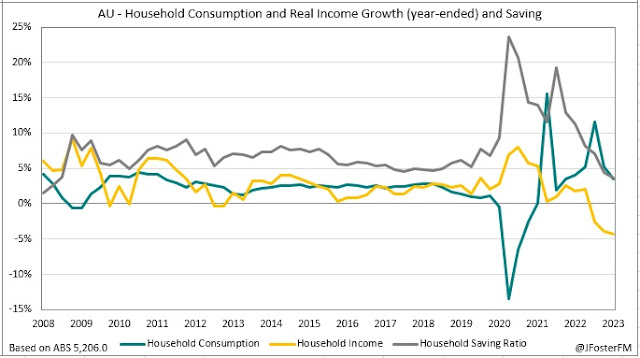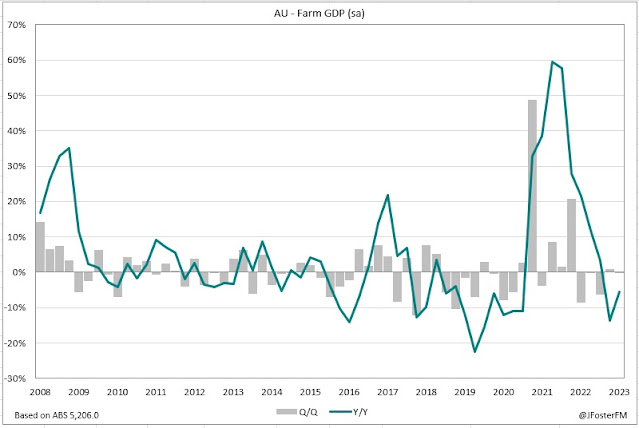Australia's economy slowed further in early 2023. Real GDP growth softened to 0.2% in the March quarter, coming in below expectations (0.3%) and downshifting from growth of 0.6% in the final quarter of last year. Excluding the Covid period, this was the weakest quarterly growth rate since late 2018. The pace of economic growth moderated from 2.6% to 2.3% through the year, but activity is now more than 7% higher than its pre-pandemic level at the end of 2019.
Slowing growth in Australia reflects a weaker economic backdrop from offshore. Growth across OECD economies was 1.5% over the year to Q1, well down from a 4.5% pace a year ago. The fading of the pandemic rebound, high inflation and rising interest rates have been some of the key factors behind this slowdown. The US economy has proved to be more resilient to these headwinds. Global growth was also supported by the removal of Covid restrictions in China; however, more recent data indicates the reopening effort there has lost momentum.
In Australia, the impulse to economic growth from household consumption, which was rising coming out of the pandemic, is now fading. This is the major driver of slower growth. Pressures on households from the cost of living, RBA rate hikes, earlier falls in housing prices and weak sentiment have contributed to the momentum in consumption turning lower.
There have been two key factors that have underpinned growth in the Australian economy over the past year: an acceleration in population growth on reopened borders and the recovery in the services export sector. Population growth has surged by 2% over the year, its strongest pace since late last decade. Growth in GDP per capita (output adjusted for the population increase) was just 0.3% over the year.
The reopening of the international border has also facilitated the recovery in the services sector, most notably in tourism and education. Services exports rebounded by around 50% through the year, contributing 2ppts to economic growth.
Inflation in Australia eased slightly in Q1 but remained elevated. A disinflationary pulse from offshore led to falls in goods and petrol prices; inflation, however, generated by domestic sources was yet to peak.
The focus of the RBA's tightening cycle has turned to respond to domestic inflationary pressures, including a 25bps hike at the June meeting that increased the cash rate to 4.1%. The strength in the labour market has led to rising wages growth, which the RBA notes has not been accompanied by a rise in productivity. In fact, measured productivity has fallen over the year (-4.5%), due to hours worked (7.1%) far outpacing economic growth (2.3%).
The RBA highlights elevated unit labour costs (7.9%) - the underlying cost of labour for firms - as posing a risk to returning inflation back to its 2-3% target "within a reasonable timeframe"; the RBA effectively argues that rising wages could become inflationary unless they are being driven (in part) by a sufficient increase in productivity (around 1%, the RBA estimates).
Looking ahead, the headwinds faced by households are set to intensify through the remainder of the year. The effects of earlier rate hikes will continue to flow through to mortgage payments; many households will move to paying much higher variable rates as their fixed-rate periods locked in during the pandemic end. However, the economy will remain supported by population growth and the labour market, while households (in aggregate) continue to hold a large amount of accumulated savings.
— — —
National Accounts — Q1 | Expenditure: GDP (E) 0.3%q/q, 2.6%Y/Y
Household consumption (0.2%q/q, 3.5%Y/Y) — The momentum in household spending slowed further amid the headwinds from cost-of-living pressures, rising interest rates, earlier declines in housing prices and weak sentiment. Household consumption growth was 0.2% in the March quarter from 0.3% in Q4, a sharp loss of momentum from the robust growth in the first half of 2022 (4.1%).
The consumption basket of households rotated to being driven by essentials (1.1%) as discretionary spending was cut back (-1.1%), indicating the post-pandemic rebound in spending effectively dried up in Q1. The decline in discretionary spending was driven by household goods (-2.4%) and new vehicle purchases (-2.2%); however, ongoing tourism demand kept transport services (4%) and hotels, cafes and restaurants (0.2%) supported.
While strong labour market conditions are supporting incomes, this is being eroded by high inflation. Real incomes were down by 0.3% in Q1 and have contracted by more than 4% over the past year, a fall of historic magnitude. Adding to this squeeze is the effect of rising interest rates. Mortgage payments lifted to 6% share of (nominal) household disposable income in Q1, the highest level in nearly a decade.
Excess savings accumulated over the pandemic - estimated to be well over $200bn in aggregate - have supported household spending. But the household saving ratio is now down to 3.7%, its lowest since 2008, and households may look to rebuild their savings buffers, particularly given very weak sentiment.
Dwelling investment (-1.2%q/q, -4.4%Y/Y) — Residential construction activity contracted by 1.2% in the March quarter and has been a headwind to the economy over the past year (-4.4%).
Capacity constraints in the availability of materials and labour, rising interest rates and an earlier downswing in housing prices are all weighing on new home building (-1.3%q/q, -1.6%Y/Y). Alterations (-0.9%, -8.2%Y/Y) continue to unwind from their peaks reached during the pandemic when they were supported by government construction subsidies.
The downturn in housing prices - a fall of around 10% from their pandemic peak - responding to the RBA's tightening cycle has seen ownership transfer costs — fees associated with real estate transactions — decline by 22% over the year, subtracting 0.4ppt from economic growth.
Business investment (2.9%q/q, 6.6%Y/Y) — A 2.9% rise in the March quarter was the strongest lift in business investment in two years, the outturn resulting in year-ended growth working up from 4% to 6.6%.
Non-dwelling construction (2.3%) picked up in the quarter and expanded strongly through the year (8.9%) as capacity constraints and adverse weather that caused earlier delays eased. Machinery and equipment spending (4.9%q/q) has also accelerated over the past year (6.6%); eased pressures in global supply chains and the reopening of the borders to allow people with the relevant technical expertise to come into the country have helped facilitate investment. Intellectual property products lifted by 1% for the second quarter running.
According to the recent ABS capital expenditure survey, forward-looking investment plans remain robust to an outlook for slower growth both domestically and offshore.
Public demand (0.8%q/q, 0.7%Y/Y) — Public demand lifted 0.8% in Q1, its strongest rise in a year, remaining elevated as a share of GDP but down from the peaks during the pandemic crisis. Public investment (4.6%Y/Y) is gaining momentum as progress in rolling out infrastructure projects is picking up. Health-related policies have kept government spending at a high level over the past year.
Inventories (0 ppt in Q1, -0.9ppt yr) — Inventories were neutral to growth in the March quarter. Although there was a large rise in wholesaler and retail inventories on the back of a rise in vehicle imports, this was offset by drawdowns in manufacturing and public authorities' inventories.
Net exports (-0.2ppt in Q1, 1.3ppts yr) — Weighed modestly on activity in Q1 (-0.2ppt) but have added strongly to growth over the past year. The reopening of the borders continues to drive exports (1.8%q/q, 10.8%Y/Y), led by the services (49.7%Y/Y) on the back of the recovery in the tourism and education sectors. Imports rebounded in the quarter (3.2%) on eased supply chain pressures and falling prices.
— — —
National Accounts — Q1 | Incomes: GDP (I) 0.2%q/q, 2.1%Y/Y
The income approach to real GDP posted growth at 0.2% in Q1 and 2.1% over the year. Higher incomes and prices are reflected in high nominal growth in Australia. Nominal GDP was up by a further 2.1% in the quarter - supported by a 2.8% rise in the terms of trade - to be up by more than 9% through the year.
Continued strength in the Australian labour market is supporting a rising wages bill. The compensation of employees lifted 2.4% in Q1 and has risen by 10.8% over the year on a combination of an increase in hours worked, faster wages growth and the use of bonuses and other incentives as firms focused on retaining staff.
Company profits (ex-financials) were 4% higher in the first quarter and are up 13.5% through the year. The manufacturing and hospitality sectors drove the rise in quarterly profits on the back of rising sales; meanwhile, wholesalers benefitted from improved margins as input prices fell.
Financial corporations profits softened in the quarter (-0.2%) and are lagging in annual terms (8.3%) as the effects of rising interest rates weigh on loan demand. Gross mixed incomes - small business and farming profits - have been hit by margin pressures due to rising prices; lacking the pricing power of larger firms (or due to declines in rural commodity prices), profits are contracting (-3.8%q/q, -4%Y/Y). Lower output is also a factor in the agriculture sector - farm GDP is down almost 6% through the year after floods impacted the east coast in 2022.
— — —
National Accounts — Q1 | Production: GDP (P) 0.2%q/q, 2.1%Y/Y
The production estimate of GDP at 0.2%q/q was in line with the headline increase in quarterly GDP but softer in the annual growth rate at 2.1%. Gross Value Added (GVA) in Q1 increased at a similar pace for both the goods production (0.5%) and goods distribution sectors (0.3%), but there was a divergence between household (0.8%) and business services (-0.6%).
In the goods production sector, output was driven by manufacturing (2.4%) on increased production of food and metals, and by the utilities industry (1.5%) as warm weather in late summer saw electricity consumption rise. The goods distribution expanded as a rebound in grain production after flooding in 2022 boosted wholesale trade (1.3%), with the associated freight logistics underpinning the transport industry (0.4%). These gains were partially offset by the retail industry (-0.5%) as households cut back discretionary spending.

Household services advanced on rising demand for health care services (1.1%). Output in accommodation and food services (0.7%) was supported by major sporting events. Increased vehicle maintenance and repairs (part of other services) was another contributor to growth (1.2%). Business services weakened in Q1. The effect of rising interest rates weighed on real estate (-1.6%) and financial services (0%). Professional services (-1.2%) and administration (-1.4%) both contracted.
— — —
National Accounts — Q1 | States
State demand has slowed sharply across the nation over the past year. Year-ended growth rates to the March quarter show state demand ranges from 1.9% at the low end (Victoria) to 2.8% at the top end (Western Australia).
Household consumption in the two major states has lost momentum over recent quarters but is remaining resilient, New South Wales posted a 0.2% rise in Q1 while Victoria lifted by 0.3%. Consumption growth in the quarter was strongest in South Australia (0.8%) and weakest in Queensland (-0.1%). Residential construction activity contracted in all states through the year to Q1. In contrast, business investment has expanded at a 7-8% annual pace in most states. Public demand has moderated from the pandemic crisis, slowing to 0.4%Y/Y in New South Wales and declining in Victoria (-1.7%Y/Y).











































































